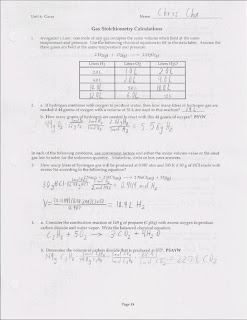We began the lesson with a review problem, we turned to packet page 16 and were assigned problem #7 to complete. Part a) was particularly easy, no surprise whatsoever. Part b) involved using converting factors, nothing particularly interesting with the possible exception of the ratio 22.4 Liters in 1 Mole of any gas at Standard Temperature & Pressure. Part c) was where things got interesting: since the reactant was not at STP, it was necessary to use PV=nRT where P=1.20 atm, n=5 Moles, R=0.08206 (a given), and T=65 degrees Celsius=338 Kelvin. Since V=(nRT)/P, the volume of the product here is equal to (5*0.08206*338)/1.20 which yields approximately 1161 Liters of acetylene. It was noted that since R is in the ratio (L*atm)/(mole*K), P should be in atm.

Next was page 15 problem #3. No different than the last; use conversion factors, solve for V using PV=nRT, and done. I'm sure it is vitally important to someone that Mr. H generously gave Kevin one Periodic Table to add to his collection of identical Periodic Tables. Here's page 15 for those who need it, answers are still just app
roximations. Under that is page 17 problems #9-10 for those who need extra practice.

Finally, it was time for a demo. Mr. H took a ping-pong ball with a hole the size of a pinhead and dipped it into a container of Liquid Nitrogen. It filled up inside the ball which was then placed on the table. Gathering up close, the students observed that as the ball spun, the Liquid Nitrogen inside was coming out through the hole and vaporizing instantly, pushing the ball in a continuous circular pattern. Of course, since the majority of developing teens have a small attention span, this got boring after 5 minutes. To shake it up a bit, Mr. H took the ping-pong ball and submerged it in the Liquid Nitrogen for several seconds and, without giving the substance time to escape the ball,

smashed the piece of plastic on the table. All around, the audience was pleased.
"But wait, there's more!" was what Mr. H should have said when he continued with these demos. He brought out the ol' vacuum pump and showed everyone what happens when the atmosphere surrounding an inflated balloon is removed. A loud and satisfying pop resulted. During this time, one student was leaning on the light switch mounted on the side of the demo table and accidentally pushed it down to the "off" setting. Much complaining and laughter ensued. It is not likely that the offender will be identified, though it is known that this student was indeed of the female gender.
Segueing awkwardly out of that tangent, Mr. H finally showed us one last demo. Another unnamed student wondered out loud what would happen if one were to suck the air out of, say, shaving cream. Answering this question, Mr. H sprayed some cream into a beaker and placed it in the chamber connected to the air sucker. Activating the vacuum, we all saw the cream rise up towards the beaker. Almost like The Blob, without getting all "theatrical." Shortly afterwards, the bell rung and class officially ended. Homework is to do WebAssign, Delicious, or both. Just do something and you'll be fine. Till next time!
No comments:
Post a Comment
Note: Only a member of this blog may post a comment.